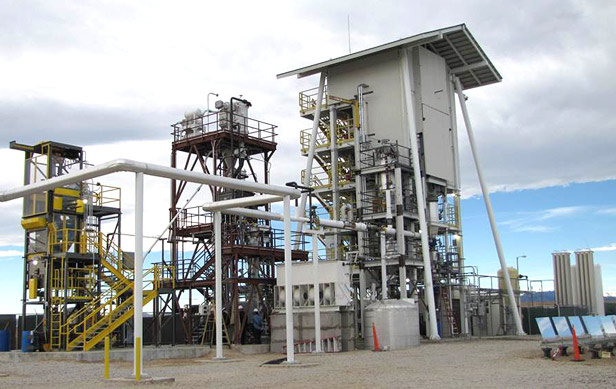A New Strategy for Advanced Biofuels: Drop the Advanced Technology

Sundrop Fuels, a startup based in Longmont, Colorado, says it has found a way to break into the notoriously difficult advanced biofuels business: it’s putting its advanced technology on hold for now, and instead building a plant for converting wood chips into gasoline. The plant will use largely off-the-shelf technology, making it easier to get loans. It’s also planning to reduce costs by using cheap natural gas to generate the high temperatures needed in the plant, rather than using concentrated sunlight, as it had originally planned.
Sundrop plans to start construction on the plant—which will have a 50-million-gallon capacity—later this year near Alexandria, Louisiana. It recently announced a partnership with Uhde Corporation of America, a partner of the German engineering firm ThyssenKrupp Uhde, to develop the detailed engineering plans for the plant. Uhde will also supply a gasifier that turns biomass into carbon monoxide and hydrogen, which can be converted with the help of catalysts into a variety of fuels.
Sundrop had planned to use its own proprietary gasification technology, which operates at high temperatures—over 1,200 ⁰C, or hundreds of degrees higher than some other gasifiers. The heat would be generated by concentrating sunlight, rather than by burning the biomass, the approach taken by other companies. Using heat from the sun would increase the amount of biomass that ends up as fuel, reducing the cost of transporting the bulky material. Operating at high temperatures would avoid the production of tars that can gum up equipment and interfere with later steps in the process.
Sundrop will continue to use high-temperature gasification to avoid tar production, but it will use a design from ThyssenKrupp that requires the introduction of oxygen. ThyssenKrupp’s technology is more expensive than Sundrop’s gasification technology, says Wayne Simmons, Sundrop’s CEO, but it’s commercially proven, which makes it easier for Sundrop to get loans to build a plant. Sundrop plans to prove its own technology by installing one of its gasifiers in the new plant, where it will be used to make about 10 percent of the plant’s output. Sundrop plans to use its gasifier technology on a larger scale in future natural-gas-powered plants.
The decision to use natural gas rather than solar heat reduces costs: in part due to recent low natural-gas prices, it’s far cheaper to burn that fuel than to build a field of mirrors to concentrate sunlight. The natural gas, in addition to heating the gasifier, will also provide a source of extra hydrogen. The ratio of hydrogen and carbon in biomass isn’t the same as in gasoline—the hydrogen from natural gas makes up the difference, increasing the fuel yield from biomass. The other option would be a reaction that uses carbon monoxide to produce hydrogen from water—but that would lower yields and force Sundrop to truck in more biomass.
Switching to natural gas had another benefit. As with the decision to use conventional gasification technology, it has helped Sundrop finance its first plant. It attracted $155 million in funding from natural-gas producer Chesapeake Energy, which was seeking to fund technologies that would increase demand for natural gas.
The use of natural gas means emissions have increased, however. When Sundrop used solar heat, its gasoline resulted in 90 percent lower carbon-dioxide emissions than conventional gasoline. But the company says the emissions will still be 60 percent lower than with conventional gasoline.
The higher cost of the conventional gasifier will also make it difficult to run the process profitably—even with the benefit of cheap natural gas. “It barely works,” Simmons says. “You wouldn’t build a whole lot of these plants, because your equity return wouldn’t be good. You do make a modest profit, but nothing like when you go to our [gasification] technology at large scale. It’s more of a strategy to get into the business.”
Keep Reading
Most Popular
Large language models can do jaw-dropping things. But nobody knows exactly why.
And that's a problem. Figuring it out is one of the biggest scientific puzzles of our time and a crucial step towards controlling more powerful future models.
The problem with plug-in hybrids? Their drivers.
Plug-in hybrids are often sold as a transition to EVs, but new data from Europe shows we’re still underestimating the emissions they produce.
Google DeepMind’s new generative model makes Super Mario–like games from scratch
Genie learns how to control games by watching hours and hours of video. It could help train next-gen robots too.
How scientists traced a mysterious covid case back to six toilets
When wastewater surveillance turns into a hunt for a single infected individual, the ethics get tricky.
Stay connected
Get the latest updates from
MIT Technology Review
Discover special offers, top stories, upcoming events, and more.